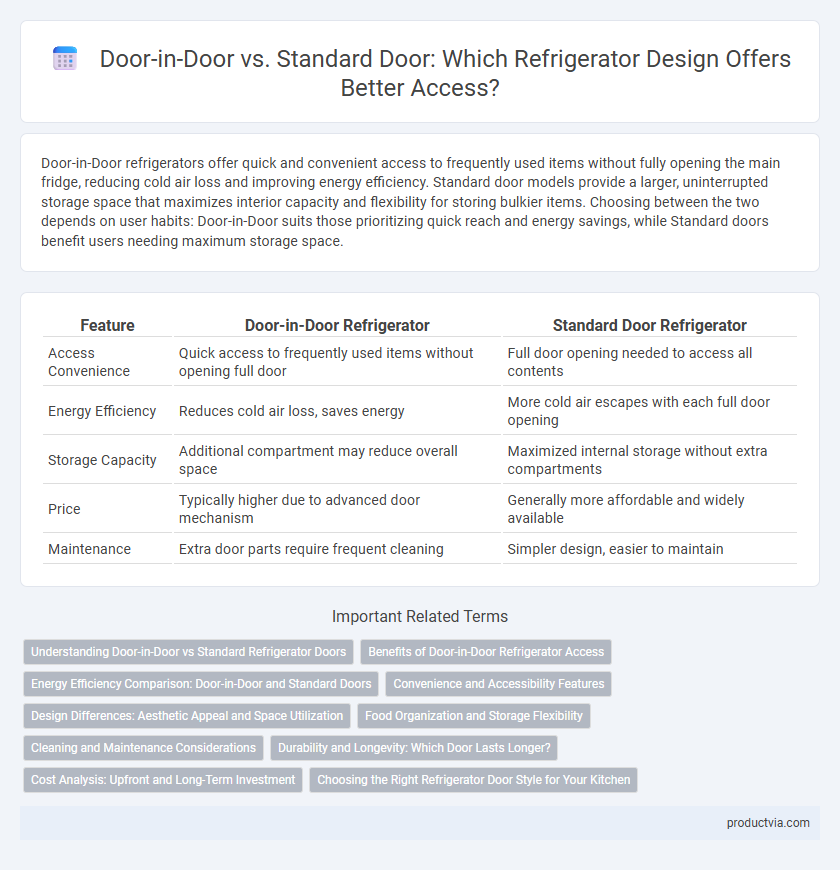Door-in-Door refrigerators offer quick and convenient access to frequently used items without fully opening the main fridge, reducing cold air loss and improving energy efficiency. Standard door models provide a larger, uninterrupted storage space that maximizes interior capacity and flexibility for storing bulkier items. Choosing between the two depends on user habits: Door-in-Door suits those prioritizing quick reach and energy savings, while Standard doors benefit users needing maximum storage space.
Table of Comparison
| Feature | Door-in-Door Refrigerator | Standard Door Refrigerator |
|---|---|---|
| Access Convenience | Quick access to frequently used items without opening full door | Full door opening needed to access all contents |
| Energy Efficiency | Reduces cold air loss, saves energy | More cold air escapes with each full door opening |
| Storage Capacity | Additional compartment may reduce overall space | Maximized internal storage without extra compartments |
| Price | Typically higher due to advanced door mechanism | Generally more affordable and widely available |
| Maintenance | Extra door parts require frequent cleaning | Simpler design, easier to maintain |
Understanding Door-in-Door vs Standard Refrigerator Doors
Door-in-Door refrigerator doors feature a secondary compartment that allows easy access to frequently used items without opening the entire fridge, improving energy efficiency and convenience. Standard refrigerator doors provide full access to the fridge interior but may result in more cold air loss and higher energy consumption. Choosing between Door-in-Door and standard doors depends on user preferences for accessibility, energy savings, and storage organization.
Benefits of Door-in-Door Refrigerator Access
Door-in-Door refrigerator access offers enhanced convenience by allowing users to reach frequently used items without opening the entire refrigerator, reducing cold air loss and improving energy efficiency. This design feature provides better organization and quicker access to snacks and beverages, minimizing temperature fluctuations inside the main compartment. As a result, food preservation is improved while lowering electricity consumption compared to standard door models.
Energy Efficiency Comparison: Door-in-Door and Standard Doors
Door-in-Door refrigerators reduce cold air loss by providing quick access to frequently used items without opening the entire fridge, resulting in improved energy efficiency compared to standard doors. Studies indicate that Door-in-Door models can lower energy consumption by up to 10% due to minimized temperature fluctuations. Standard doors, while simpler, cause more cold air escape during full-door access, increasing compressor workload and energy usage.
Convenience and Accessibility Features
Door-in-Door refrigerators enhance convenience by providing quick access to frequently used items without opening the entire fridge, reducing cold air loss and improving energy efficiency. Standard door models offer a traditional single-door access with a larger opening, which may be better for storing bulky items but requires fully opening the door for any access. Key accessibility features in Door-in-Door designs include segmented compartments and easy-to-reach shelves, while standard doors prioritize wide internal space for versatile storage.
Design Differences: Aesthetic Appeal and Space Utilization
Door-in-Door refrigerators feature an outer door that provides quick access to frequently used items without fully opening the main compartment, enhancing space utilization and minimizing cold air loss. Standard door designs open the entire fridge compartment, providing full visibility but requiring more clearance space and potentially disrupting internal temperature. The aesthetic appeal of Door-in-Door models lies in their sleek, modern look with separate access panels, while standard doors offer a classic, uniform surface that blends seamlessly with kitchen cabinetry.
Food Organization and Storage Flexibility
Door-in-Door refrigerators enhance food organization by providing a dedicated compartment for frequently accessed items, reducing cold air loss and maintaining temperature stability. This design allows for flexible storage options, enabling users to separate beverages and snacks from fresh produce and larger items. Standard door models offer broader storage capacity but often lack the segmented compartments that aid in systematic organization and quick access.
Cleaning and Maintenance Considerations
Door-in-Door refrigerators feature a secondary, smaller door that reduces spills and messes in the main compartment, simplifying cleaning by isolating frequently accessed items. Standard door models often require more extensive cleaning since the entire compartment is exposed during access, increasing the risk of spills and residue buildup. Maintenance for Door-in-Door systems may involve additional hinges and seals to clean and inspect, while standard doors typically have fewer mechanical parts to maintain.
Durability and Longevity: Which Door Lasts Longer?
Door-in-Door refrigerators feature reinforced hinges and multiple seals designed to withstand frequent use, enhancing durability compared to standard doors. Standard doors, while simpler in construction, may experience wear over time due to less robust hinge mechanisms and gasket materials. Studies indicate that Door-in-Door models often have longer lifespan components, providing better longevity for active households with frequent fridge access.
Cost Analysis: Upfront and Long-Term Investment
Door-in-Door refrigerators generally have a higher upfront cost, often ranging from $1,200 to $2,500, compared to standard door models that typically cost between $700 and $1,500. Long-term investment in door-in-door models can be justified by energy savings and convenience, as they reduce cold air loss during frequent access, potentially lowering electricity bills by 10-15%. Standard door refrigerators may require less initial investment but can result in higher operational costs due to increased energy consumption over time.
Choosing the Right Refrigerator Door Style for Your Kitchen
Door-in-Door refrigerators provide convenient access to frequently used items without opening the entire fridge, enhancing energy efficiency and reducing cold air loss. Standard door models offer larger storage capacity and simpler maintenance, fitting well in kitchens where space and ease of cleaning are priorities. Selecting the right refrigerator door style depends on your kitchen layout, lifestyle, and preference for quick access versus maximum storage space.
Door-in-Door vs Standard Door for Refrigerator Access Infographic

 productvia.com
productvia.com